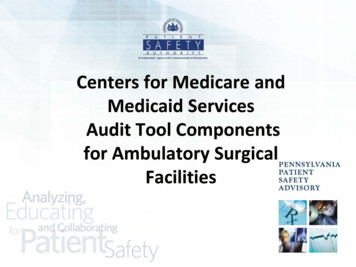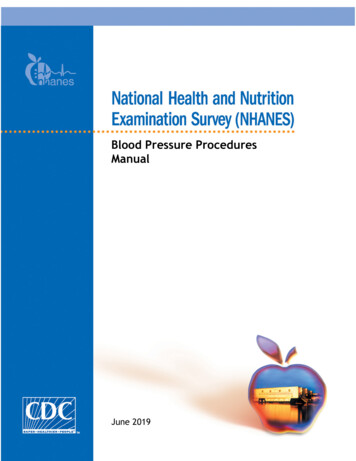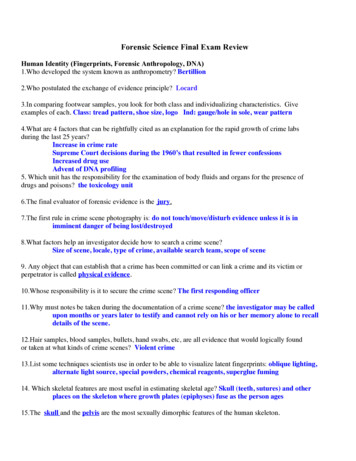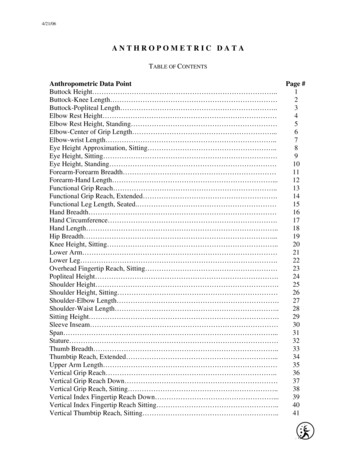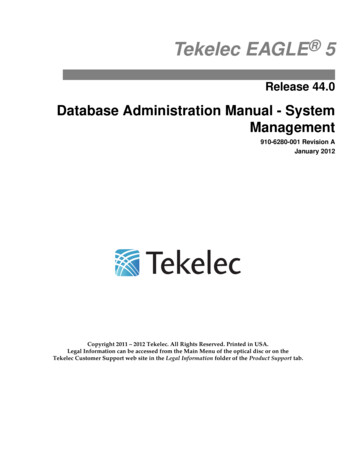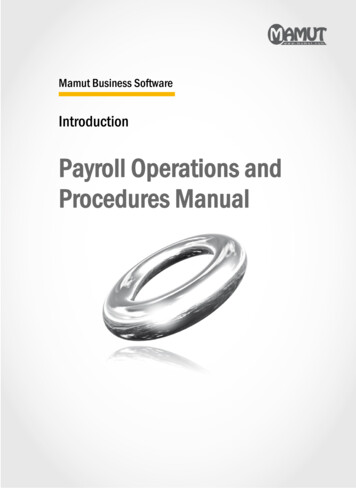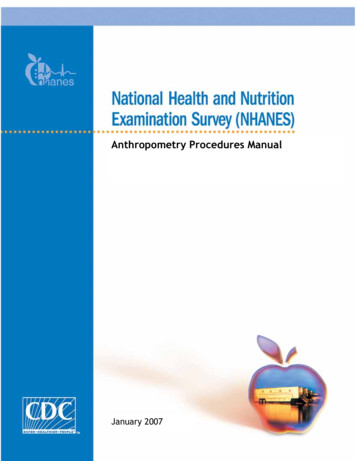
Transcription
Anthropometry Procedures ManualJanuary 2007
TABLE OF CONTENTSChapter12PageOVERVIEW OF ANTHROPOMETRY .1-11.11.21.31.41.5Background of Anthropometric Measurements.Purpose of Anthropometrics .Importance of Anthropometric Data.Overview of NHANES Anthropometry Examination .Role of Anthropometric Examiner and Recorder .1-11-11-21-41-4EQUIPMENT .2-12.12.2Description of the Body Measurement Room in the MEC.Equipment and Supplies .2-12-12.2.12.2.2Equipment .Supplies.2-12-6Setup .3.82.3.92.3.10Calibration Weights .Digital Weight Scale .Portable Scale.Sitting Box .Stadiometer .Infantometer .Skinfold Caliper .Knee Caliper.Measurement Tapes and 2-12Equipment Care and Maintenance .Equipment Malfunctions.Packup 162-162-162-162.32.42.52.6Calibration Weights .Digital Weight Scale .Portable Scale.Sitting Box .Stadiometer .Infantometer .Skinfold Caliper .Knee Caliper.Measurement Tapes and Ruler.Supplies.iii
TABLE OF CONTENTS (continued)Chapter3PageEXAMINATION PROTOCOL .3-13.13.23.33.4Eligibility Criteria .Pre-examination Procedures .General Guidelines for Measuring and Recording .Examination Procedures 4.83.4.9Weight.Recumbent Length .Head Circumference.Standing Height.Upper Leg Length .Upper Arm Length .Arm Circumference.Abdominal (Waist) Circumference .Skinfolds .3-33-53-63-73-103-123-153-153-17Special Considerations.3-233.5.13.5.23.5.33.5.43.5.5SPs in Street Clothes .Children.SPs in Wheelchairs.Amputees .Comprehension or Language Difficulties .3-233-243-243-253-25Post-examination Procedures.3-263.53.64ISIS DATA ENTRY .4-14.14.2General Screen Information.Weight Screen.4-14-34.2.14.2.2Weight Comments.Tare and Reset.4-54-6Stature Screen .4-74.3.14.3.2Height Correction.Stature Comments .4-104-10Sitting Measures Screen.Upper Arm Length Screen .4-134-144.34.44.5iv
TABLE OF CONTENTS 74-184-20QUALITY CONTROL.5-15.15.2Introduction to Quality Control for Anthropometry .Equipment Calibrations .5-15-15.2.15.2.25.2.35.2.45.2.55.2.6Digital Weight Scale .Portable Scales .Stadiometer .Infantometer .Skinfold Calipers.Equipment Swap .5-45-95-105-125-145-15ISIS Examination Screens .Observations, Replication, and Review .5-175-175.35.46Circumference Measures Screen .Skinfold Measures Screen .SP Information Screen .Amputations Screen.Anthropometry Component Status Screen.SAFETY PROCEDURES .6-16.16.26.36-16-16-2Equipment Precautions .SP Movement and Positioning.Emergency Procedures .List of AppendixesAppendixABody Measures Recording Form .A-1BProcedures for Conducting Anthropometry Gold Standard ReplicateExaminations .B-1v
TABLE OF CONTENTS (continued)List of TablesTablePage3-1Body measurements by age category.3-15-1Anthropometry equipment calibrations .5-2List of ExhibitsExhibit2-1Calibration weight (10kg) .2-42-2Digital weight scale–covered.2-42-3Digital weight scale–uncovered.2-42-4Digital scale measurement device.2-42-5Portable scale .2-52-6Sitting box.2-52-7Stadiometer headpiece and digital measurement device.2-52-8Stadiometer calibration rod.2-52-9Infantometer.2-62-10Calipers, step wedge, tape measure, ruler.2-62-11Anthropometry supplies (1) .2-82-12Anthropometry supplies (2) .2-82-13Anthropometry supplies (3) .2-93-1Head circumference tape position.3-73-2Standing height position .3-93-3Upper leg length measurement position .3-11vi
TABLE OF CONTENTS (continued)List of Exhibits (continued)ExhibitPage3-4Marking spine extending from acromion process.3-133-5Correct tape placement for upper arm length.3-133-6Incorrect tape placement for upper arm length .3-133-7Marking upper arm length midpoint .3-133-8SP position for upper arm length and midpoint .3-143-9Abdominal (waist) circumference mark .3-163-10Measuring tape position for abdominal (waist) circumference.3-163-11Correct skinfold measurement .3-173-12Incorrect skinfold measurement.3-183-13Triceps skinfold measurement .3-203-14Location of subscapular skinfold .3-223-15Subscapular skinfold mark.3-223-16Subscapular skinfold measurement.3-224-1Logon SP screen .4-14-2ISIS screen characteristics .4-24-3Edit check box .4-34-4Weight screen .4-44-5Weight screen – lb kg warning message.4-54-6Weight screen – comments list .4-64-7aStature screen – SPs 0-6 mos .4-8vii
TABLE OF CONTENTS (continued)List of Exhibits (continued)ExhibitPage4-7bStature screen – SPs 7-23 mos .4-84-7cStature screen – SPs 24-47mos .4-94-7dStature screen – SPs 4yrs .4-94-8aStature screen – Recumbent length blank comments.4-114-8bStature screen – Standing height value comments.4-124-9Sitting measures screen.4-134-10Upper arm length screen .4-144-11Circumference measures screen.4-154-12Skinfold measures screen.4-164-13SP information screen .4-174-14Amputations screen.4-194-15Anthropometry component status screen - complete.4-214-16Anthropometry component status screen - partial .4-215-1Body measures quality control checks.5-25-2Digital weight scale full calibration.5-45-3Digital weight scale daily calibration .5-55-4Digital scale display device .5-65-5Digital weight scale full calibration – scale set to lb .5-75-6Digital weight scale daily calibration – scale set to lb.5-75-7Digital weight scale full calibration – lb setting error message .5-8viii
TABLE OF CONTENTS (continued)List of Exhibits (continued)ExhibitPage5-8Digital weight scale daily calibration – lb setting error message.5-85-9Portable scales calibration.5-95-10Stadiometer calibration: In calibration.5-115-11Stadiometer calibration: Out of calibration – recalibrated.5-115-12Infantometer calibration: In calibration .5-135-13Infantometer calibration: Out of calibration – recalibrated .5-135-14Skinfold caliper calibration.5-155-15Equipment swap – blank.5-165-16Equipment swap – skinfold caliper swapped.5-16ix
1. OVERVIEW OF ANTHROPOMETRY1.1Background of Anthropometric MeasurementsAnthropometry is the study of the measurement of the human body in terms of thedimensions of bone, muscle, and adipose (fat) tissue. The word “anthropometry” is derived from theGreek word “anthropo” meaning “human” and the Greek word “metron” meaning “measure” (Ulajaszek,1994). The field of anthropometry encompasses a variety of human body measurements. Weight, stature(standing height), recumbent length, skinfold thicknesses, circumferences (head, waist, limb, etc.), limblengths, and breadths (shoulder, wrist, etc.) are examples of anthropometric measures.Several indexes and ratios can be derived from anthropometric measurements. Perhaps themost well-known indicator of body fatness is the body mass index or “BMI.” BMI values are calculatedfor NHANES participants using measured height and weight values as follows: weight (kilograms)/height(meters2). BMI criteria are used to screen for weight categories: underweight (BMI values 18.5), normalor desirable weight (BMI values 18.5-24.9), overweight (BMI values 25.0-29.9), obese-Class I (BMIvalues 30.0-34.9), obese-Class II (BMI values 35.0-39.9) and extremely obese (BMI values 40.0)(National Institutes of Health, 1998). NHANES BMI results are used to track weight trends in the U.S.population. The National Institutes of Health, Centers for Disease Control and Prevention (CDC), andmany other research groups have reported on the health risks associated with overweight and obesityusing NHANES interview and health examination data.1.2Purpose of AnthropometricsThe purpose of the NHANES anthropometry component is to collect high quality bodymeasurement data using standardized examination procedures and calibrated equipment. Accurate dataare fundamental to the evaluation of anthropometric trends over time. It is crucial for researchers to knowthat the differences that occur between NHANES surveys reflect true differences in the NHANES bodymeasurement values rather than technician and protocol variability and/or measurement error. In order toensure the collection of high quality data, NHANES staff are trained to follow standardized examinationprotocols, to calibrate equipment according to a prescribed schedule and method, and to measure andrecord the survey data with precision. Additionally, retraining sessions, gold standard examinations1-1
performed by expert examiners, and field observations are conducted on a regular basis to reinforce theimportance of measurement precision and standardized data collection methodology.1.3Importance of Anthropometric DataAnthropometry is a key component of nutrition status assessment in children and adults(Simko). The NHANES anthropometry data have been used to track growth and weight trends in the U.S.population for more than thirty years (Flegal, 2002; Hedley, 2004). The anthropometric data for infantsand children reflect general health status and dietary adequacy and are used to track trends in growth anddevelopment over time. The CDC has used NHANES data to produce national reference standards or“growth charts.” The CDC growth charts are used extensively by pediatricians and researchers in the U.S.and abroad (Kuczmarski, 2002). A description of the history and statistical methodology that was used todevelop the latest growth charts can be found at the CDC web site: http://www.cdc.gov/growthcharts/.The highly publicized NHANES data trends showing increases in overweight and obesity among U.S.children and adolescents underscore the importance of NHANES to provide continuous health data(Ogden, 2002).The NHANES anthropometric data are used to evaluate health and dietary status, diseaserisk, and body composition changes that occur over the adult lifespan. Researchers in diverse healthdisciplines including cardiovascular health, gerontology, nutrition, and occupational health useanthropometric data to examine health status and health care utilization trends in U.S. adults. Current U.S.demographic trends project significant growth among race/ethnic subgroups and adults 75 years andolder. These trends are reflected in the NHANES sample, which includes a large proportion of adults 60years and older, African Americans, and Hispanics. Racial and ethnic minorities are more likely to bemedically underserved compared to non-Hispanic whites in terms of having a regular source of healthcare, health insurance, and access to preventive health services. Valuable health information onpopulation groups that might not be reflected in other health reporting systems is routinely collected insurveys sponsored by the National Center for Health Statistics (NCHS).With respect to the “graying” U.S. population, the “baby boomer” generation is approachingretirement age. What will their quality of life be like during their “golden years?” How much health carewill older persons need to maintain their health? What types of health conditions will be more prevalentamong older Americans? Functional status and general well-being are inevitably linked to weight status.1-2
A recent analysis of the NHANES 1999-2002 data using BMI criteria determined that overweight andobese individuals were more likely to report fair or poor health (rather than good or excellent health),activity limitations, and more health provider visits per year compared to normal weight adults(McDowell, 2006).The NHANES skinfold thickness and circumference measures assess subcutaneous andvisceral fat tissue. Recent reports based on NHANES showed increasing mid-arm circumferencemeasurements in children and adults (Ostchega, et al. 2005 and 2006). These data have been used toformulate guidelines for health practitioners regarding the selection of blood pressure cuff sizes forchildren and adults. In addition, the NHANES waist circumference data are widely used to assesscardiovascular disease risk. Specifically, individuals who have large deposits of abdominal fat tissue areat increased risk for hypertension, adult-onset diabetes mellitus, cardiovascular disease, gallstones,arthritis, and some forms of cancer.Although much of the attention in today’s popular media is on overweight and obesity,NHANES data can also be used to track trends in underweight. Underweight may occur due to a varietyof factors, such as: poor nutrition and eating habits, substance abuse, chronic illness, medication therapy,surgical procedures, and other health problems.Finally, NHANES is the only study that produces national estimates for the U.S.population—all ages and all sizes. NCHS continues to publish reports based on the NHANESanthropometry data. National reference data for children and adults based on NHANES 1999-2002 areavailable through the CDC web site at the following link: http://www.cdc.gov/nchs/data/ad/ad361.pdf .The NHANES body measures examination data files are also publicly available and may be downloadedfrom the NHANES web site: http://www.cdc.gov/nchs/nhanes.htm. To retrieve information on theNHANES anthropometry training methodologies and examination protocols, refer to the following ic procedures training manuals used for each NHANES, as well as the NHANES IIIAnthropometric Procedures Video. Lastly, hyperlinks for data, questionnaires, and manuals for eachNHANES survey are also provided on the NHANES web site.1-3
1.4Overview of NHANES Anthropometry ExaminationThe NHANES anthropometry or body measures examination is conducted in trailer 1 of themobile examination center (MEC). All NHANES participants or sample persons (SPs) are eligible for theanthropometry examination component. Specific measurements are completed dependent on the age ofthe participant. The complete set of measurements includes weight, height, upper leg and arm length,mid-arm and waist circumference, and triceps and subscapular skinfolds. The anthropometry examinationprotocol and procedures are described in Chapter 3, Examination Protocol. A health technologist andrecorder work as a team to collect the anthropometry data. Examination results are saved to the studydatabase using the Integrated Survey Information System (ISIS) anthropometry computer application.Funding for the anthropometry examination component is provided solely by NCHS.1.5Role of Anthropometric Examiner and RecorderThe anthropometry component is staffed by trained health technicians and recorders. TheNHANES health technologists may serve as examiners or recorders for this component. In addition, otherMEC staff are trained to record anthropometry examination results. When two health technologists areassigned by the MEC coordinator to the anthropometry room, the technologist assigned as the examinershould complete the entire examination.The examiner will position the participant, take all measurements, and tell the recorder themeasurement values to record as described in Chapter 3, Examination Protocol. The recorder will enterthe examination results in the ISIS anthropometry component software application. The ISIS module isprogrammed to present the anthropometry data entry screens in the correct sequence based on the age ofthe participant. The ISIS interface is also pre-programmed with age- and gender-specific edit ranges foreach measurement, based on results from earlier NHANES. This feature is designed to reduce data entryerrors that may result from either incorrect measurement or data entry errors. See Section 4.3, ISISExamination Screens, for details on the quality control features of the ISIS anthropometry application. If arecorded value falls outside the pre-programmed edit range, the ISIS system will alert the recorder thatthe recorded value is unusual. The recorder should always ask the examiner to verify the measurementvalue before proceeding to the next measurement. If a measurement or recording error was made, therecorder will enter the correct value; if the original value is correct, the value is retained. Since NHANESincludes participants of all shapes, sizes, and body builds, some unusual values are legitimate; however,1-4
measurement and recording errors do occasionally occur. Therefore teamwork between the examiner andrecorder is essential in order to measure and record accurate data.Another important duty of the recorder is to help the examiner position the participantsduring their examination. In this role the recorder also alerts the examiner if the respondent needs to berepositioned. For example, when the waist circumference is determined, the recorder checks that the tapemeasure lies parallel to the floor and snug, but without compressing the skin. Also, the recorderparticipates in taking recumbent length measurements on infants and young children. Assistance is neededbecause several body sites must be aligned to obtain an accurate measurement. Lastly, the recorder marksbody sites that are measured by the examiner and hands equipment and supplies to the examiner whenneeded.ReferencesAnthropometric reference data for children and adults: U.S. population. 1999–2002. Advance data fromvital and health statistics; no. 361. Hyattsville, MD: National Center for Health Statistics. 2005.Available at: http://www.cdc.gov/nchs/data/ad/ad361.pdfClinical Guidelines on the Identification, Evaluation, and Treatment of Overweight and Obesity inAdults--The Evidence Report. National Institutes of Health. Obes Res. 1998, Sep. 6. Suppl 2:51S209S. Also available at: http://www.nhlbi.nih.gov/guidelines/obesity/ob gdlns.htm (AccessedAugust 21, 2006).Flegal KM, Carroll MD, Ogden CL, Johnson CL. Prevalence and trends in obesity among U.S. adults,1999-2000. JAMA. 2002, Oct. 9. 288(14):1723-7.Hedley AA, Ogden CL, Johnson CL, Carroll MD, Curtin LR, Flegal KM. Prevalence of overweight andobesity among U.S. children, adolescents, and adults, 1999-2002. JAMA. 2004, June 16.291(23):2847-50.Kuczmarski RJ, Ogden CL, Guo SS, Grummer-Strawn LM, Flegal KM, Mei Z, Wei R, Curtin LR, RocheAF, Johnson CL. 2000 CDC Growth Charts for the United States: methods and development.(2002 May). Vital Health Stat 11. (246):1-190.McDowell MA, Hughes JP, Borrud LG. Health characteristics of U.S. adults by body mass indexcategory: results from NHANES 1999-2002. (2006). Public Health Rep., 121:67-73.Ogden CL, Flegal KM, Carroll MD, Johnson CL. Prevalence and trends in overweight among U.S.children and adolescents, 1999-2000. 2002, Oct 9. JAMA. 288(14):1728-32.1-5
Ostchega, Y., et al. Tables for the selection of correct blood pressure cuff size based on self-reportedheight and weight and estimating equations for mid-arm circumference: data from the U.S.National Health and Nutrition Examination Survey. (2006) Jan. J Hum Hypertens. 20(1):15-22.Ostchega, Y., et al. U.S. demographic trends in mid-arm circumference and recommended blood pressurecuffs: 1988-2002. 2005 Nov. J Hum Hypertens. 19(11):885-91.Simko M and Cowell C. (1995). Nutrition Assessment: A Comprehensive Guide for PlanningIntervention. Second Edition. Jones and Bartlett.Ulijaszek, SJ. (1994). Anthropology: The Individual and the Population. Cambridge University Press.1-6
2. EQUIPMENT2.1Description of the Body Measurement Room in the MECThe body measurement room is located in trailer 1 of the MEC. The room is equipped withunique features designed to facilitate accurate and efficient measurement, including: a wall mirror tofacilitate waist circumference measurements; a custom-built box where SPs can sit for the upper leglength measurement; and a digital floor scale that is housed in an opening in the floor. Additionally, theelectronic equipment, namely the scale, stadiometer, and infantometer are linked electronically to theNHANES Integrated Survey Information System (ISIS) for quick and accurate data entry.2.2Equipment and SuppliesA brief description of the anthropometry component equipment and supplies is providedbelow. In addition, Exhibits 2-1 to 2-13 contain photographs of these items for reference.2.2.1Equipment Calibrati
dimensions of bone, muscle, and adipose (fat) tissue. The word “anthropometry” is derived from the Greek word “anthropo” meaning “human” and the Greek word “metron” meaning “measure” (Ulajaszek, 1994). The field of anthropometry encompas



